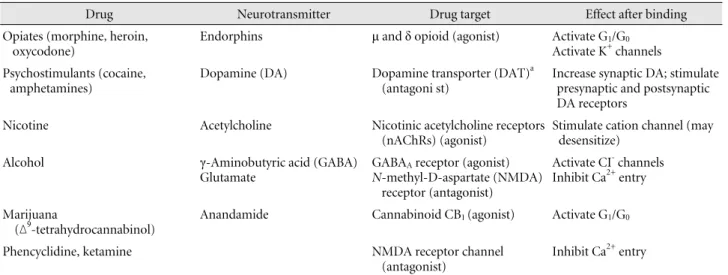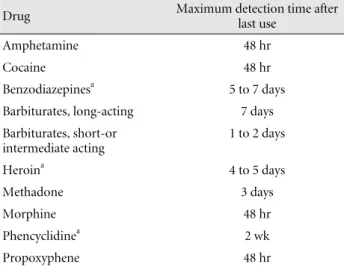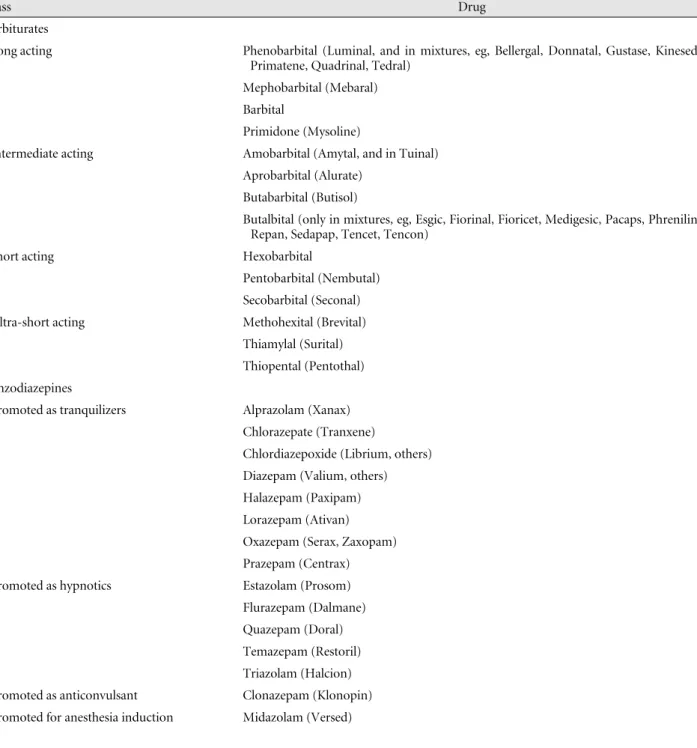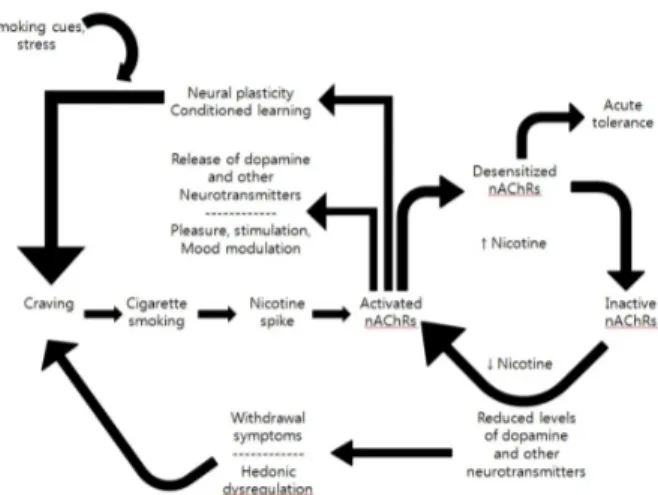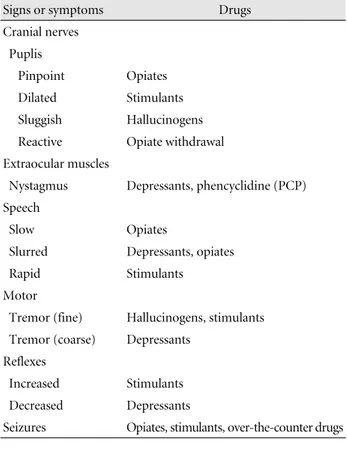Received: December 26, 2012 / Revised: December 28, 2012 / Accepted: December 28, 2012 Address for correspondence: Dong Kuck Lee, MD
Department of Neurology, Catholic University of Daegu School of Medicine, 33 Duryugongwon-ro 17-gil, Nam-gu, Daegu 705-718, Korea Tel: +82-53-650-4267, Fax: +82-53-654-9786, E-mail: dklee@cu.ac.kr
약물 남용과 의존
대구가톨릭대학교 의과대학 신경과학교실
이 동 국
Drug Abuse and Dependence
Dong Kuck Lee, MD
Department of Neurology, Catholic University of Daegu School of Medicine, Daegu, Korea
ABSTRACT There are two kinds of drug dependence. Psychic dependence leads to craving and drug-seeking behavior.
Physical dependence produces somatic withdrawal symptoms and signs. Depending on the particular drug and the circumstances of its administration, psychic and physical dependence can coexist or occur alone.
Addiction is psychic dependence. Drug addiction is defined as compulsive substance use despite serious negative consequences. Harmful drug use and addiction are significant contributors to medical morbidity and mortality both directly as a result of the toxic effects of abused drugs and indirectly through accidents, violence, nonsterile needle use, and other health hazards. By far the greatest contributors to illness and death are the widely used legal drugs, tobacco and alcohol, although illegal addictive drugs and abused prescription drugs also exact a significant toll. In addition, addiction creates enormous burdens on society by impairing the function of the addicted person in multiple life roles, disrupting families and neighborhoods, and motivating crime.
(J Pain Auton Disord 2013;2:31-41) KEYWORDS Drug dependence, Addiction, Abuse
서 론
약물의존은 정신적 (psychic) 의존과 육체적(physical) 의존 으로 나눈다 . 정신적 의존은 자주 약물을 찾고 갈망하게 만 들고 육체적 의존은 신체적으로 금단 증상과 징후를 일으킨 다. 정신적 의존과 육체적 의존은 공존하기도 하고 단독으로 있기도 한다. 중독(addiction)이란 정신적 의존을 말한다. 내성 (tolerance)이란 종전과 같은 양을 써서는 효과가 없어 원하는 효과를 얻기 위해 더 많은 양의 약물을 필요로 하는 상태이
다. 민감화(sensitization)란 약물을 반복투여 하는 가운데 약
효가 크게 나타나는 상태로 역내성(reverse tolerance)이라고도
한다. 전 세계적으로 수많은 약물들이 정신적 욕망을 위해 쓰
이고 있다 . 대표적으로 남용되고 있는 약물들로는 아편유사제
(opioids), 정신자극제(psychostimulants), 수면제, 진정제(sedatives),
대마초(marijuana), 환각제(hallucinogens), 흡입제(inhalents),
phencyclidine, 항콜린제(anticholinergics), 담배, 및 알코올 등
이 있다. 그러나 이런 약제들은 중독 경향, 중독, 과용 및 금
단 증상과 징후, 및 남용 후 합병증 등이 각각 다르다.
1-5Figure 2. Stages of addiction to drug of abuse.
Figure 1. Brain reward circuits.
Table 1. Properties of addictive drugs
Drug Neurotransmitter Drug target Effect after binding
Opiates (morphine, heroin, oxycodone)
Endorphins μ and δ opioid (agonist) Activate G
1/G
0Activate K
+channels Psychostimulants (cocaine,
amphetamines)
Dopamine (DA) Dopamine transporter (DAT)
a(antagoni st)
Increase synaptic DA; stimulate presynaptic and postsynaptic DA receptors
Nicotine Acetylcholine Nicotinic acetylcholine receptors
(nAChRs) (agonist)
Stimulate cation channel (may desensitize)
Alcohol γ-Aminobutyric acid (GABA)
Glutamate
GABA
Areceptor (agonist) N-methyl-D-aspartate (NMDA)
receptor (antagonist)
Activate CI
-channels Inhibit Ca
2+entry
Marijuana
(ᐃ
9-tetrahydrocannabinol)
Anandamide Cannabinoid CB
1(agonist) Activate G
1/G
0Phencyclidine, ketamine NMDA receptor channel
(antagonist)
Inhibit Ca
2+entry
a
The psychostimulants also interact with the norepinephrine and serotonin transporters, but under normal conditions, it is the DAT that is critical for rewarding and addictive properties. Unlike cocaine, amphetamines enter dopamine through the DAT and interact with a second target, the vesicular monoamine transporter (VMAT), to release DA into the cytoplasm and thence, through the DAT, to release if into the synapse.
본 론 1. 약물 남용과 의존
1) 총론5-7
인간이 생존하는 가운데 보상 (reward)은 삶을 즐겁게 하는 중요한 기능으로 약물중독에서 큰 역할을 한다 . 인간의 뇌보 상회로(reward circuits)는 배쪽 덮개부위(ventral tegmental area) 에서 accumbens 핵을 통해 전두엽 피질과 띠이랑(cingulate
gyrus)으로 전달되는 구조와 흑질(substantia nigra)에서 등쪽
줄무늬체(striatum)로 전달되는 구조로 구성되어 있으며 이런
과정에는 도파민이 중요한 역할을 한다(Fig. 1). 한편 약물을
사용하는 많은 사람들 가운데 일부에서만 남용과 중독이 생
긴다. 특히 남성과 중독 가족력이 있으면 중독 위험성이 더
커진다 . 쌍둥이와 입양아 연구결과로 보아 유전자도 가족적
위험성을 높이는 데 역할을 한다. 최근에는 흡연과 음주에서
는 남녀 성별 차이가 크게 줄어들고 있다. 한편 약물남용 시
중독의 전체 과정은 그림 2와 같다. 또한 중독약물의 특성은
Table 2. Common drugs of abuse: Approximate detection time after last drug use when drugs or their metabolites are still detectable in urine
Drug Maximum detection time after
last use
Amphetamine 48 hr
Cocaine 48 hr
Benzodiazepines
a5 to 7 days
Barbiturates, long-acting 7 days Barbiturates, short-or
intermediate acting
1 to 2 days
Heroin
a4 to 5 days
Methadone 3 days
Morphine 48 hr
Phencyclidine
a2 wk
Propoxyphene 48 hr
a
Maximum detection times given for chronic users. Single dose in nonhabitual users is cleared more rapidly.
Table 3. Opioids currently or recently available Agonist
Powdered opium
Tincture of opium (laudanum)
Camphorated tincture of opium (paregoric) Purified opium alkaloids (Pantopon)
Morphine (Morphine sulfate injection; MS contin; Oramorph) Heroin (legally available only for investigational use)
Methadone (Dolophine)
Fentanyl (Sublimaze; in Innoval; Duragesic patch) Sufentanil (Sufenta)
Alfentanil (Alfenta)
Oxymorphone (Numorphan) Hydromorphone (Dilaudid) Codeine
Dihydrocodeine (Synalgos)
Oxycodone (Oxy-contin, and in mixtures, eg, Percodan, Percocet, Tylox)
Hydrocodone (in mixtures, eg, Hycodan, Lortab, Lorcet, Tussionex, Vicodin)
Levorphanol (Levo-Dromoran)
Meperidine (pethidine; Demerol, Pethadol) Alphaprodine (Nisentil)
Propoxyphene (Darvon, and in Darvocet, Wygesic) Diphenoxylate (in Lomotil)
Apomorphine Antagonist
Naloxone (Narcan) Naltrexone (Trexan) Nalmefene (Revex) Mixed agonist-antagonist
Pentazocine (Talwin, Talwin Nx, and in Talacen) Butorphanol (Stadol)
Buprenorphine (Buprenex) Nalbuphine (Nubain) 표 1과 같고 흔히 남용되는 약물의 마지막 사용 후 소변에서
검출되는 시간은 표 2와 같다.
2) 각론2-11
(1) 아편유사제
아편유사제는 작용제(agonist), 길항제(antagonist), 및 두 가 지가 혼합된 약제로 나눌 수 있다. 아편유사제 작용제를 중 독 수준까지 쓰면 몽롱한 이상황홀감(euphoria), 축동(miosis), 진통 , 및 기침억제 등이 생기고 가끔 오심, 구토, 가려움, 저 체온 , 체위(postural) 저혈압, 변비, 및 성욕감퇴 등이 생긴다.
헤로인을 주사나 담배형태로 투여하면 이상황홀감이 있은 후 황홀경(ecstasy)을 느끼며 편안하게 고개를 끄덕이거나 또 는 수다스럽게 과활동을 보이기도 한다. 아편유사제를 과용 량 주면 혼수, 심한 축동, 및 호흡저하가 생긴다. 치료로는 호 흡을 도와주면서 naloxone을 2 mg부터 시작하여 경과를 보 면서 20 mg까지 반복해서 정맥주사한다. 만약 호흡이 정상이 라면 금단증상을 줄이기 위해 naloxone 0.4-0.8 mg을 준다. 그 러나 neloxone은 작용시간이 짦으므로 잘 관찰해야 한다.
아편유사제 작용제의 금단증상으로는 과민 , 눈물, 콧물, 하 품, 땀, 산동(mydriasis), 근육통, 근수축, 열, 오심, 구토, 털세 움(piloerection), 복통, 빈맥, 얼굴 화끈거림, 고혈압, 및 성극 치감 (orgasm) 등이 있다. 성인에서는 발작과 섬망(delirium)은
나타나지 않지만 신생아에서는 발작과 근간대경련(myoclonus)
이 나타나 아주 위험하다 . 치료로는 methadone을 쓰며 신생
아에서는 paregoric을 쓴다. 아편유사제 의존의 치료로는 작
용시간이 긴 작용제인 methadone이나 작용제와 길항제 혼합
형인 buprenorphine으로 대체한다(Tables 3, 4).
Table 4. Opiate overdose Discriminating features
Positive urine toxicology screen for heroin or morphine Reversal by naloxone, a specific opiate antagonist Consistent features
Pinpoint pupils Respiratory depression Coma
Variable features
Postanoxic encephalopathy
Infectious complications including AIDS Ischemic infarction
Table 5. Psychostimulants Amphetamine (Benzedrine) Dextroamphetamine (Dexedrine)
Amphetamine and dextroamphetamine (Biphetamine) Methamphetamine (Methedrine; Desoxyn; Fetamin) Methylenedioxymethamphetamine (MDMA; "Ecstasy") Methylenedioxyethylampheramine (MDEA)
Cocaine Ephedrine Pseudoephedrine Methylphenidate (Ritalin) Pemoline (Cylert)
Phenmetrazine (Preludin; Prelu-2) Diethylpropion (Tenuate; Tepanil) Benzphetamine (Didrex)
Fenfluramine (Pondimin) (withdrawn) Dexfenfluramine (Redux) (withdrawn) Phendimetrazine (Plegine; Bontril)
Phentermine (lonamin; Wilpo; Adipex-P; Fastin) Mazindol (Sanorex; Mazanor)
Phenylpropanolamine (Propadrine; Propagest; and in decongestants and diet pilis) (withdrawn)
Propylhexedrine (Benzedrex nasal inhaler)
Naphazoline (Privine nasal solution; Naphcon ophthalmic solution)
Tetrahydrozoline (Tyzine nasal solution; Visine ophthalmic solution)
Oxymetazoline (Afrin nasal solution; OcuClear ophthalmic solution)
Xylometazoline (Otrivin nasal solution) Phenoxazoline (nasal solution)
Table 6. Cocaine and amphetamine abuse Discriminating features
Positive urine toxicology screen for cocaine or amphetamines Consistent features
Hyperactivity, tremor, anorexia Tachycardia, increased blood pressure Dilated pupils
Variable features Generalized seizures Hemorrhagic stroke
Paranoia, delusions of crawling bugs with amphetamine Choreiform movement disorder with amphetamine Amphetamine-induced vasculitis
(2) 정신자극제
정신자극제에는 amphetamine 유사제, 코카인, methylphenidate, 충혈제거제(decongestant)에 포함된 물질들, 식이요법제(diet pill), 및 식이요법 보조제 등이 포함된다. 특히 amphetamine 과 코카인은 남용하면 발작을 가장 잘 일으키는 대표적인 약 물이다. 이런 약을 먹으면 이상황홀감이 생기고 운동량이 증 가하며 지구력이 강화된다. Methylenedioxymethamphetamine (MDMA, ecstacy)는 amphetamine과 환각제인 mescaline의 중 간 정도되는 특성을 보인다. 코카인은 코로 흡입하거나 정맥 주사하거나 정제로 먹거나 또는 담배처럼 흡연하기도 한다.
코카인을 정맥주사나 담배처럼 흡연하거나 methamphetamine
을 투여하면 황홀감이 생긴다. 그러나 반복투여하면 이갈이,
이상운동, 편집증(paranoia), 심지어는 환각성 정신병을 보인
다. 과량투여하면 두통, 흉통, 고혈압, 빈맥, 심방 및 심실 부
정맥 , 열, 흥분, 섬망, 발작, 근간대경련, 및 마이오글로빈뇨
등을 보인다. 심하면 혼수나 쇼크가 생기고 악성 고열이나
파종혈관내응고(disseminated intravascular coagulation)가 일어
나며 심지어 사망하는 경우도 있다. 특히 amphetamine과 코
카인은 뇌내 및 지주막하 출혈을 잘 일으킨다. 또한 교감신
경작용제가 많이 포함된 다이어트 보조제를 먹으면 뇌졸중
위험이 증가한다. 치료는 우선 진정시킨 후 산소를 흡입시키
면서 bicarbonate와 항경련제를 주고 혈압을 유지하면서 체온
을 떨어뜨리고 심장과 호흡기능을 도와 준다. 정신자극제를
금단하면 피로, 배고픔, 및 우울증이 생기며 다른 뚜렷한 징
후는 없지만 자살충동은 위험하다 (Tables 5, 6).
Table 7. Sedatives/Hypnotics
Class Drug
Barbiturates
Long acting Phenobarbital (Luminal, and in mixtures, eg, Bellergal, Donnatal, Gustase, Kinesed, Primatene, Quadrinal, Tedral)
Mephobarbital (Mebaral) Barbital
Primidone (Mysoline)
Intermediate acting Amobarbital (Amytal, and in Tuinal) Aprobarbital (Alurate)
Butabarbital (Butisol)
Butalbital (only in mixtures, eg, Esgic, Fiorinal, Fioricet, Medigesic, Pacaps, Phrenilin, Repan, Sedapap, Tencet, Tencon)
Short acting Hexobarbital
Pentobarbital (Nembutal) Secobarbital (Seconal)
Ultra-short acting Methohexital (Brevital)
Thiamylal (Surital) Thiopental (Pentothal) Benzodiazepines
Promoted as tranquilizers Alprazolam (Xanax) Chlorazepate (Tranxene)
Chlordiazepoxide (Librium, others) Diazepam (Valium, others) Halazepam (Paxipam) Lorazepam (Ativan) Oxazepam (Serax, Zaxopam) Prazepam (Centrax)
Promoted as hypnotics Estazolam (Prosom)
Flurazepam (Dalmane) Quazepam (Doral) Temazepam (Restoril) Triazolam (Halcion) Promoted as anticonvulsant Clonazepam (Klonopin) Promoted for anesthesia induction Midazolam (Versed)
(3) 진정제
진정제에는 barbiturates, benzodiazepine 및 기타 등이 있다 (Table 7). 진정제의 약효, 과량 사용 및 금단증상은 ethanol과 유사하다. 호흡억제작용은 barbiturates보다 benzodiazepine이 약하다. 과량을 복용했을 때 치료는 지지요법이다. Benzo- diazepine에 특수한 길항제인 flumazenil은 약효가 짧으므로
치료보다는 과량복용을 진단하는 데 유용하게 쓰인다. 금단
진전과 발작은 barbiturates와 benzodiazepine의 용량을 조절하면
예방할 수 있다 . ethanol에서와 마찬가지로 진전 섬망(delirium
tremens)은 응급상태이므로 집중치료가 필요하다. 만약 진정
제를 ethanol과 같이 먹으면 진정, 호흡억제, 초조(agitation),
환각, 혼수 등이 나타나며 치료는 지지요법이다.
Table 7. Continued
Nonbarbiturate, nondenzodiazepine, sedative-hypnotics
Buspirone (Buspar)
Chloral hydrate (Noctec, others) Chlormezanone (Trancopal)
Diphenhydramine (Benadryl, and in over-the-counter sleep pills, eg, Miles Nervine, Nytol, Sleep-Eze, Sominex, Compoz)
Ethchlorvynol (Placidyl)
Ethinamate (Valmid, no longer produced in the US) Glutethimide (Doriden, after 1991 available only as generic) Hydroxyzine (Vistaril, Atarax, others)
Meprobamate (Miltown, Equanil; in Equagesic with aspirin; in Deprol with benactyzine)
Methaqualone (Quaalude, Sopar, no longer produced in the US) Methyprylon (Nodular, no longer produced in the US)
Paraldehyde
Triclofos (Triclos, no longer produced in the US) Zaleplon (Sonata)
Zolpidern (Ambien, Stilnox, Niotal)
Table 8. Hallucinogenic compounds Ergot-derived
D-Lysergic acid diethylamide (LSD) Indolealkylamines
Psilocybin Psilocin
N, N-dimethyltryptamine (DMT) N, N-diethyltryptamine (DET) Phenylalkylamines
Mescaline
2, 4-Dimethoxy-4-methylamphetamine (DOM) 4-Bromo-2, 5-dimethoxyamphetamine (DOB) 2, 5-Dimethoxy-4-ethylamphetamine (DOET)
3-Methoxy-4, 5-methylenedioxyamphetamine (MMDA) 3, 4-Methylenedioxyamphetamine (MDA)
(4) 대마초
Cannabis sativa라는 대마의 잎과 꽃으로 만든 대마초에는 정신활동물질인 △-9-tetrahydrocannabinol이 많이 포함되어 있다 . 특히 대마 수지(resin)로 만든 hashish에는 이 성분이 더 많다 . 대마초는 먹어도 효과가 있지만 대부분 흡입한다. 그 결과 몽롱한 이상황홀감이 생기고 익살스러워지며 감정을 억제하지 못하고 이인증(depersonalization), 빈맥, 및 체위저 혈압 등이 생기면서 시간이 천천히 가는 것처럼 느끼게 된다.
고용량에서는 환청, 환시, 혼동(confusion), 및 정신병 등이 생 기지만 치명적이지는 않다. 금단증상은 가벼우며 안절부절하 고 두통을 호소하며 정신적 의존을 보인다.
(5) 환각제
환각제에는 여러 종류가 있다(Table 8). 환각제의 급성 효 과로는 환각, 지남력 상실, 기분변화, 이인증, 진전, 어지럼, 및 이상감각 등이 있고 편집증이나 공황장애도 생길 수 있다.
LSD를 과량쓰면 고혈압, 의식저하, 발작, 및 치명적 사고 등 이 생긴다. 과량썼을 때의 치료로는 일단 조용한 환경에 두 고 안심시키면서 필요하면 benzodiazepine을 쓴다. 그러나 금 단증상은 없다 .
(6) 흡입제
흡입제는 특히 청소년들이 잘 쓰는 약물로 다양한 종류가 있다(Table 9). 약효는 ethanol 중독 때와 비슷하지만 과량 쓰 면 환각이나 발작이 생기고 혼수에 빠지기도 한다. 심장 부 정맥, 사고, 질식, 및 구토물의 흡입 때문에 사망하기도 한다.
약효는 대부분 수시간 지나면 사라진다. 그러나 호흡과 심장
Table 9. Products subject to inhalant abuse and their contents
Products Contents
Aerosols (refrigerants, flying pan cleaners, antitussives, hair sprays, bronchodilators, shampoos, deodorants, antiseptics, pain killers)
Fluorinated hydrocarbons, propane, isobutane
Dry cleaning fluids, spot removers, furniture polish, degreasers Chlorinated hydrocarbons, naphtha (gasoline hydrocarbons) Glues, cements, rubber patching Toluene, acetone, benzene, aliphatic acetates, n-hexane,
cyclohexane, trichloroethylene, xylene, butyl alcohol,
dichloroethylene, methylethylketone, methylethylisobutylktone, chloroform, ethanol, triorthocresyl phosphate
Lighter fluid Aliphatic and aromatic hydrocarbons
Fire-extinguishing agents Bromochlorodifluoromethane
Fingernail polish remover Acetone, aliphatic acetates, benzene
Bottled fuel gas Butane, propane
Typewriter correction fluid Trichloroethane, trichloroethylene
Natural gas Methane, ethane, propane, butane
Marker pens Toluene, xylene
Mothballs Naphthalene, paradichlirobenzene
Toilet deodorizers Paradichlorobenzene
Paints, enamels, lacquers, lacquer and paint thinners Toluene, methylene chloride, aliphatic acetates, benzene, ethanol Petroleum (gasoline, naphtha gas, benzine) Many aliophatic, aromatic, and other hydrocarbons (eg, olefins,
naphthanes), including butane, hexane, pentane, benzene, toluene, and xylene; tetraethyl lead
Anesthetics (surgical supply, whipped cream dispensers) Nitrous oxide, diethyl ether, halothane, chloroform, enflurane, isofiurane, trichloroethylene
"Room odorizers" Amyl, butyl, and isobutyl nitrite
기능을 잘 살피는 것이 중요하며 금단증상은 약하다.
(7) phencyclidine
이 약은 대부분 흡입하며 중독증상은 약용량과 비례한다 (Table 10). 약 복용 후 중증 정신병과 섬망이 생기면 신체를 억제하고 benzodiazepine으로 진정시킨다. 또한 항고혈압제나 항경련제를 쓰면서 체온을 낮추고 강제 이뇨 (diuresis)시키면서 심장 호흡 및 신장기능을 잘 살핀다. 신경이완제(neuroleptics) 를 쓰면 저혈압 , 발작, 및 미오글로빈뇨 등이 생기므로 피한 다. 정신적 의존이 생기지만 안절부절하거나 진전같은 금단 증상은 드물다 .
(8) 항콜린제
이 약에 중독되면 입이 마르고 땀분비가 줄어 들며 빈맥이 생기면서 열이 나고 동공이 커지며 반응이 없어지고 섬망과 환각이 생기면서 진행되면 근간대경련, 발작, 및 혼수가 생기 고 사망한다. 치료로는 physostigmine을 쓰면서 위장을 세척
하고 체온을 낮추며 도뇨하고 호흡과 심장기능을 살핀다. 필 요하면 항경련제를 쓴다. 신경이완제는 항콜린작용을 가지고 있으므로 쓰면 안된다 . 그러나 금단증상은 생기지 않는다.
(9) 담배
담배에서 중독물질은 니코틴이다. 담배 흡연의 육체적 의 존징후는 약하지만 담배를 피우고 싶은 욕구는 참기 힘들 정 도로 강력하다 . 많은 흡연가들이 금연하고 싶어하지만 대부 분 실패하는 일이 많다 . 니코틴 중독의 생물학은 그림 3과 같고 분자(molecular) 및 행동측면은 그림 4와 같다.
(10) 알코올
알코올은 가장 흔히 쓰이는 정신활동물질로서 중추신경계
를 억제하는 기능이 있다. 알코올을 많이 먹으면 중독증상이
오고 장기간 먹으면 인지기능이 떨어지며 갑자기 중단하면
금단증상이 온다. 알코올 중독자가 국소 발작을 일으키면 뇌
Figure 4. Molecular and behavioral aspects of nicotine addiction.
Table 11. Chronic alcohol abuse Discriminating features
Symptoms of alcohol withdrawal after abrupt cessation of drinking often with generalized seizures
Development of delirium tremens 3-5 days after ethanol withdrawal
Consistent features
Hypomagnesemia, hypokalemia Chronic cerebellar syndrome Alcoholic polyneuropathy Alcoholic brain disease Variable features
Acute or chronic alcololic myopathy Wernicke-Korsakoff syndrome Central pontine myelinolysis Table 10. Phencyclidine poisoning: Approximate order of
symptoms with increasing dose Relaxation, euphoria
Anxiety, emotional lability, dysphoria, paranoia Subjective time-slowing
Decreased sensory perception Altered body image, sensory illusions Amnesia
Agitation, bizarre or violent behavior Analgesia
Synesthesia Nystagmus Miosis
Tachycardia, hypertension Hyperpnea
Fever
Hypersalivation, sweating Dysarthria, ataxia, vertigo Psychosis (paranoid or catatonic) Hallucinations
Dystonia, opisthotonus Myoclonus
Rhabdomyolysis Seizures
Stupor or coma with blank stare Extensor posturing
Respiratory depression Hypotension
Figure 3. The biology of nicotine addiction.
에 구조적인 문제가 생긴 것을 뜻한다 . 알코올 중독자에게 티아민 없이 포도당만 주면 Wernicke 뇌병증이 악화된다. 알 코올 금단 발작을 보이는 환자중 일부는 뇌전증으로 발전하 여 장기간 항경련제를 복용해야 한다. 진전 섬망은 치명적이 므로 응급으로 처치해야 한다. 만성 알코올 중독증상은 표 11 과 같다 .
2. 약물 남용의 합병증2-4,7,8,12 1) 총론
약물남용의 신경학적 증상과 징후는 Table 12, 13과 같다.
Table 12. Neurological consequences of drug abuse Direct neurological complications of drug abuse Acute intoxication and overdose
Drug withdrawal syndrome
Indirect neurological complications of drug abuse Infectious complications
Endocarditis
Cerebral or spinal cord abscess Meningitis or encephalitis Myelopathy
Toxin-mediated disorders Wound botulism Tetanus Strokes
Cerebral or spinal cord infarct Postanoxic encephalopathy Hemorrhage
Brachial plexitis Nerve compression Rhabdomyolysis
Table 13. Summary of neurologic signs and symptoms of drug abuse
Signs or symptoms Drugs
Cranial nerves Puplis
Pinpoint Opiates Dilated Stimulants Sluggish Hallucinogens Reactive Opiate withdrawal Extraocular muscles
Nystagmus Depressants, phencyclidine (PCP) Speech
Slow Opiates
Slurred Depressants, opiates
Rapid Stimulants
Motor
Tremor (fine) Hallucinogens, stimulants Tremor (coarse) Depressants
Reflexes
Increased Stimulants Decreased Depressants
Seizures Opiates, stimulants, over-the-counter drugs
2) 각론(1) 외상
약물의 급성 효과로 외상이 잘 생긴다 . 특히 대마초나 흡 입제를 쓰면 자동차 사고나 기타 사고가 잘 생기고 정신자극 제를 쓰다보면 난폭해 져서 사고가 일어나기 쉬우며 환각제 를 쓰면 자해하기 쉽다. 특히 노인에서 진정제를 쓰다보면 넘어져 사고 당하기 쉽다. 불법적인 약물을 쓰는 경우에는 항상 사고 위험이 크다.
(2) 감염
정맥주사로 자주 약물을 투약하는 사람들은 국소적이거나 전신 감염위험이 크다. 특히 연조직염(cellulitis), 골수염(osteo- myelitis), 간염, 심내막염, 수막염, 뇌농양, 파상풍, 보툴리즘, 또는 말라리아 등이 잘 생길 수 있다. 따라서 신경 합병증도 흔히 생긴다. 또한 후천선 면역결핍증후군, 매독, 및 결핵 등 도 잘 걸리고 HTLV-1과 HTLV-2 감염으로 진행성 척수병증 이 잘 생기기도 한다 .
(3) 발작
약물을 남용하는 사람들은 중독증상의 하나로 중추신경계 감염이 생겨 발작하거나 금단증상으로 발작이 발생한다.
benzodiazepine을 포함한 진정제는 금단하면 발작하기 쉽다.
신생아에서와는 다르게 아편유사체는 금단해도 발작이 거의 생기지 않는다 . 아편유사체는 발작역치는 낮추지만 헤로인을 과용해도 발작은 드물다 . 그러나 다른 아편유사체와는 다르 게 meperidine은 활성 대사체인 normeperidine을 만드므로 발 작과 근간대경련을 일으킨다. Pentazocine을 항히스타민과 같 이 쓰면 발작이 잘 일어난다. 코카인을 쓰면 다른 독작용 없 이도 발작이 잘 생긴다. Amphetamine같은 정신자극제를 쓰 면 발작은 드물다.
(4) 뇌졸중
약물남용은 뇌졸중 위험을 증가시키며 특히 35세 이하의
젊은 사람에서 뇌졸중의 가장 중요한 위험인자가 된다. 또한
약물을 복용하거나 주사하면서 술과 담배를 같이 하는 경우
Table 14. Probable mechanisms of strokes associated with drug abuse
Intravenous drug abuse
Endocarditis, infectious or marantic Embolization of foreign materials
Right-to-left shunt in heart and pulmonary vasculature Mycotic aneurysm
Direct effects of drugs Vascular injury Arterial dissection Acute severe hypertension Vasoconstriction or vasospasm Impaired vascular autoregulation Hypotension or anoxia
Indirect effects of drugs Vasculitis
Effect on preexisting vascular malformation or aneurysm Cardiomyopathy and arrhythmia
Antiphospholipid antibodies
Nephropathy and secondary hypertension
HIV infection and acquired immunodeficiency syndrome
에는 뇌졸중 위험이 더 증가한다. 주사로 약물을 자주 주입 하는 사람들은 심내막염, 간염 및 AIDS 같은 병과 연관되어 뇌졸중이 잘 생긴다. 헤로인도 별다른 위험인자 없이 면역기 전을 통해 뇌졸중을 일으킨다. 아편유사제를 주사하면 후천 성 폐 동정맥 션트를 통해 이물질이 뇌에 전달되어 허혈성 뇌졸중이 생긴다. Amphetamine 같은 정신자극제는 급성 고 혈압을 일으켜 뇌출혈이 잘 생긴다. 또한 면역매개 혈관염을 일으켜 허혈성 뇌졸중을 만들기도 한다. 코카인과 연관된 뇌 졸중은 이미 많이 보고되어 있으며 뇌출혈과 뇌경색이 반반 정도이다. 기존 동맥류나 혈관기형이 있는 사람에서 갑자기 혈압이 오르면 뇌출혈이 잘 생기고 직접적인 뇌혈관 수축 때 문에 뇌경색이 생긴다. MDMA를 자주 사용하는 사람에서 뇌 내출혈이나 지주막하 출혈이 잘 생긴다 . LSD나 PCP는 혈관 을 수축시킨다 (Table 14).
(5) 의식변화
불법약물을 자주 사용하는 사람은 두부 외상, AIDS 같은 감염 , 영양실조, 또는 에타놀 남용 등으로 인해 인지기능 저
하가 생기기 쉽다. 그러나 약물을 남용하는 사람들에 대해 정신상태에 대한 기초조사가 없고 이미 정신질환을 동반하 고 있는 경우가 많으며 또한 신체의 다른 불편한 증상들 때 문에 기타 약을 복용하고 있는 일이 많으므로 인지기능이나 행동장애를 정확히 평가하기가 힘들다. 그러나 아편유사제와 환각제는 영원한 인지기능 장애를 일으키지는 않는 것으로 알려져 있다. 또한 methadone을 수십년간 써도 인지기능과 행동에는 특이한 이상소견이 없었다고 한다. 그러나 아편유 사제 의존상태에 있는 사람에서 뇌MRI를 찍어 보면 변연 계(limbic system)에 기능적 연결이 감소되어 있다. 또한 만성 대마초 흡입자는 기억력 , 실행력, 및 섬세한 일을 하는 기능 등의 인지기능이 감소되어 있으며 대마초를 많이 흡입한 청 소년은 정신분열병 위험이 증가한다. Amphetamine, metham- phetamine, 또는 MDMA는 연접신경말단을 손상시키므로 만 성적으로 사용하면 인지기능이 떨어진다 . 그러나 코카인은 연접신경손상은 일으키지 않지만 전반적인 뇌허혈을 일으키 므로 인지기능이 떨어진다. Toluene을 코로 흡입하면 뇌백질 이상과 치매가 온다. 노인 흡연자들은 인지기능이 떨어지고 알츠하이머병과 혈관성 치매가 증가한다.
(6) 태아에 미치는 효과
불법약물이 태아에 미치는 영향은 단순히 약물 외에도 함 께하는 흡연이나 ethanol, 영양실조, 산전관리 부족, 및 적절 하지 못한 가정환경 등 다양한 인자들이 영향을 미친다고 생 각된다 . 헤로인과 methadone을 포함한 기타 아편유사제는 심 한 신생아 금단증상을 일으키고, 일부 영아들은 연령에 비해 크기가 작으며 호흡이 힘든 증상을 보이고 커서는 인지기능 이 저하된 소견을 보인다 . 한편 산모가 코카인을 복용하면 영아가 출생후 24개월 정도까지 근육긴장항진(hypertonia)을 보이지만 그 후 인지기능장애에 대해서는 잘 모른다. MDMA 를 포함한 정신자극제를 사용 후 인지기능에 대한 영향은 잘 모르지만 대마초를 피우면 출생 시 키와 체중이 줄고 나중에 경도의 인지기능장애가 생긴다. Toluene과 기타 흡인제는 기 형가능성을 높인다 .
3. 기타 효과들2-4
약물남용과 의존은 근육 , 신경, 척수, 대뇌 및 소뇌에 다양한
효과를 나타내고 호르몬 변화도 일으킨다.
1) 근육, 신경, 및 척수
헤로인, 코카인, 기타 정신자극제, 및 PCP 등을 쓰면 횡문 근융해(rhabdomyolysis)와 신부전 위험이 높아진다. 한편 헤 로인을 장기 사용하면 길랑 바레 증후군 형태의 말초신경병 과 상완 및 요천추 신경얼기병(plexopathy) 가능성이 있다.
n-hexane이 포함된 물질을 코로 흡입하면 중증 감각운동 말 초신경병이 생긴다 . 아산화질소(nitrous oxide)를 코로 흡입하 면 cobalamin 부족 때와 감별이 힘든 척수신경병이 생기고 헤로인 사용자에서는 혈관성으로 추정되는 급성 척수병이 생긴다.
2) 대뇌
흑질의 신경원에 독성을 가진 MPTP란 물질에 오염된 mepheridine 유사체를 쓰면 회복불가능한 중증 파킨슨증이 생긴다. 금속박(metal foil) 위에 두고 가열한 헤로인을 흡입하 면 해면모양 백질뇌병증(spongiform leukoencephalopathy)가 생겨 치매가 오고 사지마비가 생기며 실명하고 심하면 사망 하게 된다.
3) 소뇌
Toluene을 흡입하면 보행실조와 소뇌 백질에 변화가 생긴다.
4) 호르몬
대마초는 황체형성호르몬 (LH)과 난포자극호르몬(FSH)을 억제하므로 남성에서는 회복가능한 발기부전과 불임을 일으 키고 여성에서는 월경불순을 일으킨다.
결 론
최근 사회적으로 약물중독과 의존이 점점 증가하고 있다 . 약물의존은 크게 정신적 의존과 육체적 의존으로 나누며 중 독이란 정신적 의존을 말한다. 정신적 의존은 자주 약물을 찾고 갈망하게 만들고 육체적 의존은 신체적으로 금단 증상
과 징후를 일으킨다 . 전 세계적으로 수많은 약물들이 정신적 욕망을 위해 쓰이고 있다. 대표적으로 남용되고 있는 약물들 로는 아편유사제, 정신자극제, 수면제, 진정제, 대마초, 환각 제, 흡입제, phencyclidine, 항콜린제, 담배 및 알코올 등이 있 다. 그러나 이런 약제들은 중독 경향, 과용 및 금단 증상과 징후, 및 남용 후 합병증 등이 각각 다르므로 통증을 치료하 는 의료인들은 진료 시 이런 사항을 숙지하고 있어야 할 것 으로 생각한다.
REFERENCES
